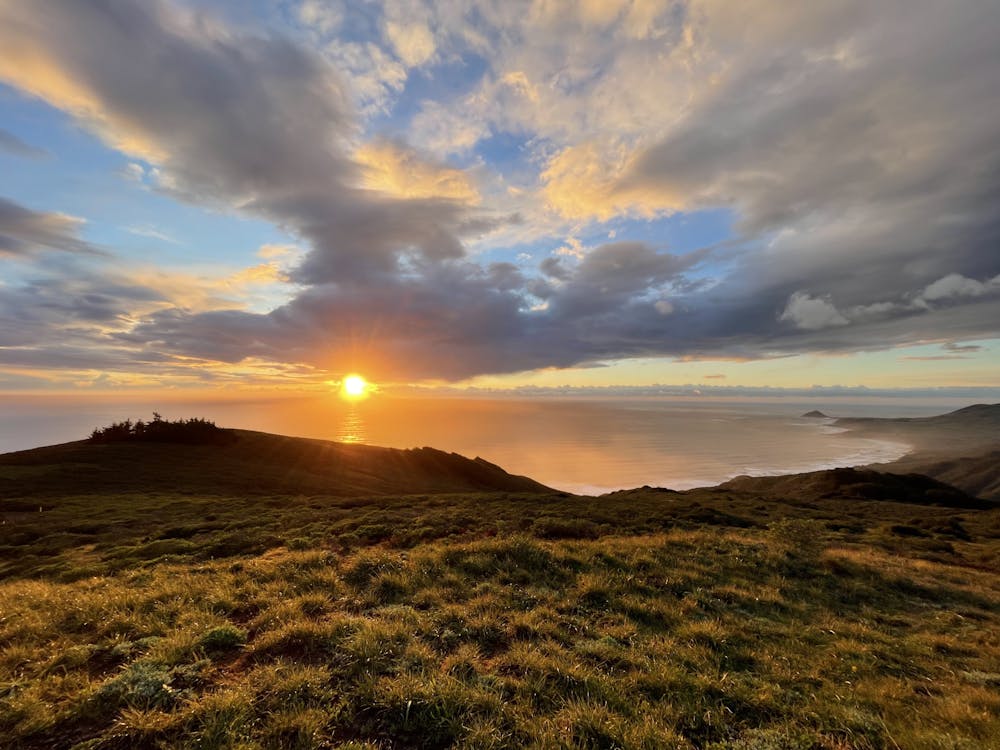When dawn broke over the Santa Lucia Mountains, I could hear the waves breaking against the cliffs of the Big Sur coastline as the stars began to fade away. As the sun started to bring pastels to the sky, bringing out the mountains’ contours, I sat up on my sleeping pad to be confronted by the vastness of the dark blue Pacific. The weather held, revealing a welcome sight of sun in between the season’s atmospheric rivers that rendered most of Big Sur inaccessible through the semester. My classmate and I were the only people on the trail that day. Our trip took us through the low brush and wildflowers that littered open hillsides and across the path of a bobcat on the prowl. It was a 40-minute drive back to campus, just in time to catch the Sunday pickup soccer game at the Middlebury Institute of International Studies (MIIS).
Coming from Colorado, I originally saw Monterey as just part of the endless southern California sun and fun. I quickly discovered that a warm day would peak at a mild 70 degrees, and some sunshine was in fact a luxury throughout the year. The palm trees of my visions were replaced by the endemic Monterey cyprus and giant redwoods that soak up the fog and clouds. The Monterey coastline is beautifully jagged and intense. Storms tear at the rocks and sand, and sea otters are far more commonplace than I ever expected. Monterey has an abundance of life and is a wonderful change of pace from the intensity of school, social buzz and snow in Middlebury.
This past spring, the Coasts and Climate semester that Monterey hosts had only four students, including myself. I harbored reservations about the group dynamics that this would create with one history major, one computer science major and two economics majors. But throughout the semester we grew closer over beach sunsets and Chipotle.
The Coasts and Climate Semester is marketed as an environmental studies program, but it fulfills far more than the “crunchy Feb'' trope that dominates the Environmental Studies program at the Vermont campus. I was the only student in the course with any background in environmental science. Two of my required courses focused on the California environmental experience. The courses were catered to engage the personal and academic backgrounds of my non-environmental science classmates.
The Middlebury Institute gave me the opportunity to take a class with the Environmental Policy and Management students, and I became part of their program. I became a poor addition to their weekly trivia team and joined their Friday Happy hours hosted by the faculty in the garden. The classroom time was interesting and gave me the opportunity to take classes unlike any I could take at Middlebury. The graduate school pedagogy of learning by doing is baked into the experience; my experiences of tide pooling to learn about invasive species and transcribing an 1830s whaling logbook emphasized exploration.
Through an independent study with the National Oceanic and Atmospheric Administration (NOAA), Monterey gave me the opportunity to do a lot of hands-on learning. I was able to run an economics research project on salmon conservation in California out of the research lab in Santa Cruz. Most days spent in the office ended with surfing at Steamer Lane, the famed Santa Cruz surf break. Working with NOAA gave me the opportunity to spend a day on a research vessel with scientists doing marine acoustics research. Most of the outing was spent 200 miles from the shore, looking for buoys and fighting sea sickness. On our way offshore, we were in a parade of breaching gray and humpback whales. Risso's dolphins shimmered underneath the boat as they flew around the water — not a bad start to spring break. I am not sure I will ever have a learning experience akin to my experience in Monterey again during my academic career. Learning in Monterey extends far past the walls of the classroom. I learned more about myself in this program than I ever have through any combination of essays, exams and discussions.
Outside of the classroom I had the opportunity to develop my own interests and introduce them to my cohort. Monterey was an amazing launchpad for exploring the rest of California — in a mere couple of hours I could reach San Francisco to the north and Los Angeles to the south south by the spectacular coastal Highway One. I was able to take my classmate on her first camping trip in Santa Barbara. After a day of surfing and walking around the city, we drove up a suburban road passing extravagant homes built into the contours of the mountainside to find our scenic campsite. She was a good sport but spent most of the night sleeping in the passenger seat of the car.
Monterey is knowing that a day of classes is never just another day in the office. It is when a surfing session goes wrong and you show up to trivia with your professor with nine new stitches in your face. It is learning how to cook really, really good brussel sprouts. It is learning that 25 year olds claim to be “zillenials” without knowing what rizz means.
Monterey will never be captured in its entirety in this article. I left out field trips, surfing, wildlife, bars, hiking, exploring, coffee and gin. Stopping at the bakery on the way to class on a cold morning, the thrill of jumping in the freezing water when the surf is good, s’mores on the beach as the sun sets with friends and the rush outdoors when the sun breaks through the clouds. There is a lot more I would love to say about Monterey, but I am limited to the space on a newspaper page. This place will always hold a special place in my heart.


